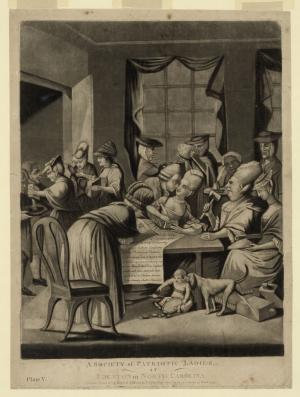Tea with Penelope

The decisions citizens make about social and political issues are often influenced by what they see, hear and read in the news. Therefore, it is important for them to learn about the techniques used to convey those messages and influence attitudes. In this lesson, students will use a graphic organizer to analyze and evaluate a political cartoon for its meaning, value and persuasive message.
One to three 45-minute class periods
- Students will discuss and analyze a political cartoon to determine the point of view of the creator
- Students will use the point of view to discuss general attitudes leading to the Revolutionary War
- Students will discuss the significance of Penelope Barker’s actions in organizing the first political demonstration by women in the United States. Did Penelope Barker set an example for the future?
Make copies of the political cartoon, A Society of Patriotic Ladies, at Edenton, North Carolina, October 25, 1774. You can either download and print these, show a copy on a Smart Board or print a poster sized copy.
Optional-Portray Penelope Barker. Set up the room for a tea party. After a brief historical interpretation, analyze the political cartoon, then serve tea during the discussion.
- Copies of political cartoon, A Society of Patriotic Ladies, at Edenton, North Carolina, October 25, 1774
- Copy of Arthur Iredell’s Letter to James Iredell, January 31, 1775
- Graphic Organizer (pg 5)
- (Optional) Tea Party Supplies (coffee urn, apple juice, tea cups, cookies, napkins, serving tea pot)
- Lesson Plan pdf
- (Optional) Dress in colonial costume. Introduce yourself as Penelope Barker. Give background historical information to lead up to the tea party at Elizabeth King’s home.
- Ask students, “What is the purpose of a political cartoon?”
- Discuss the techniques of political cartoon artists to persuade their audience.
- Symbolism-using symbols to stand for larger ideas
- Exaggeration-Over exaggerating physical characteristics or things to make a point
- Labeling-labeling a part of the cartoon to draw attention to and make clear their standpoint or belief
- Analogy-making a comparison between two unlike objects
- Irony-the difference between the way things are and they way they should be or are expected to be
- Distribute copies of the political cartoon, A Society of Patriotic Ladies, at Edenton, North Carolina. Also, distribute graphic organizer, Tea with Penelope: A 2 Point Political Perspective.
- Show a 2-Point perspective painting. Discuss the technique of drawing in the middle ground, foreground and background. Call students’ attentions to the fact that the organizer is divided into middle ground, foreground and background. Discuss the middle ground, foreground and background of the political cartoon. (I would divide it up with what is happening on the floor, observations of those at the table, and what is going on behind the table.) Ask students to write down as many observations as they can on the graphic organizer and decide on the main technique used by the artist.
- During tea which in this case would be apple cider (optional), discuss student observations and ask the following questions:
- What type of technique was used by the artist?
- What perspective do you think the artist was trying to get across?
- If a cartoon is meant to persuade, what do you think Philip Dawe, the artist was trying to accomplish?
- Explain to the students that the image, A Society of Patriotic Ladies, appeared in the London newspaper on March 25, 1775. The women are portrayed with masculine features, and represent various social backgrounds to include a slave. In the foreground, a child is playing without supervision. You can also see a dog licking its face, and also urinating on a box of tea. In the middle ground, the ladies are signing the petition, but you also see a man leering at the woman. In the background, a lady is drinking from the punch bowl while the others appear to be socializing. In the political cartoon, Dawes insinuates that the women were not behaving as ladies. He suggests that the colonial protests were led by those (the ladies) who were unfit to express political opinion or hold political power.
- Tell the students the reason why this is called 2-Point perspective is because there is always more than one opinion to every story. Share the letter from Arthur Iredell to James Iredell, January 31, 1775 and ask students what they think Arthur Iredell is saying.
Ask students to find a current political cartoon. Analyze the cartoon to determine the artist’s persuasion technique and message. Hold discussions to voice the 2 perspectives to the argument.
D2.His.10.3-5. Compare information provided by different historical sources about the past.
D2.His.13.3-5. Use information about a historical source, including the maker, date, place of origin, intended audience, and purpose to judge the extent to which the source is useful for studying a particular topic.
